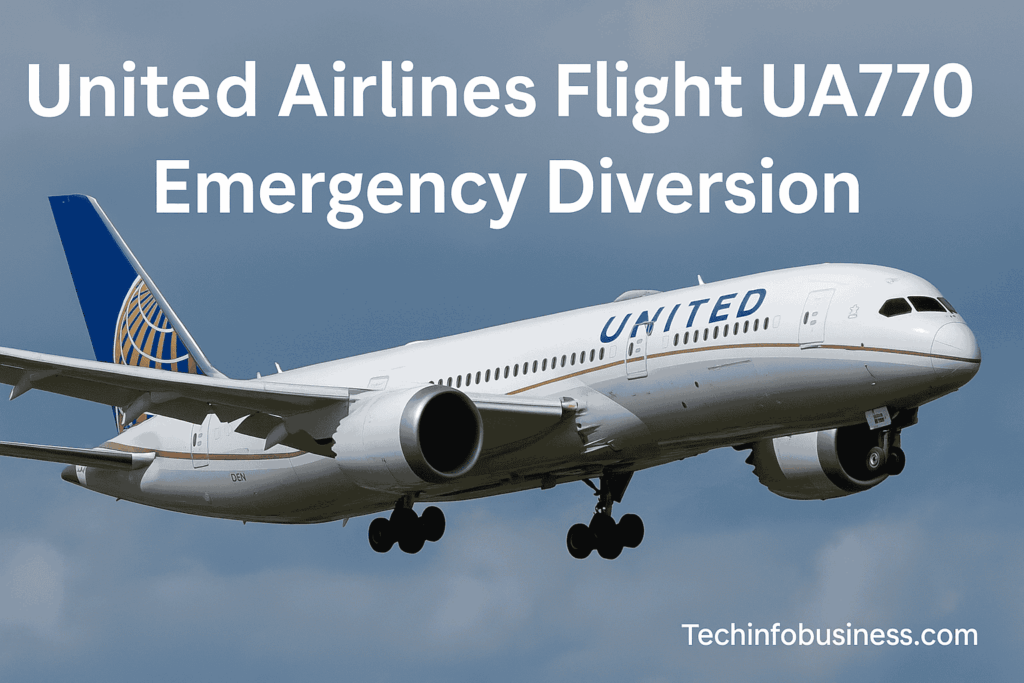The aviation industry is no stranger to unexpected challenges. Among them, mid-air diversions are some of the most critical decisions a flight crew may face. One such incident that brought attention to aviation safety protocols occurred with United Airlines Flight UA770, a long-haul journey that underwent an emergency diversion en route from Barcelona to Chicago. The situation unfolded rapidly in the skies, but its roots are deeply embedded in the systems, decision-making, and protocols that define modern aviation.
This article unpacks every angle of the United Airlines Flight UA770 emergency diversion, including the cause, crew response, airport logistics, and what this means for passengers and the airline industry.
The Flight Overview: UA770’s Scheduled Path
United Airlines Flight UA770 was a scheduled transatlantic passenger service operating between Barcelona El-Prat International Airport (BCN) and Chicago O’Hare International Airport (ORD). The aircraft used was a Boeing 787-9 Dreamliner, a modern twin-engine jet known for fuel efficiency and long-range capability. Departing from Spain on the morning of May 27, 2025, the flight was expected to take approximately 9 hours and 30 minutes, cruising over the Atlantic before entering North American airspace.
The aircraft took off with approximately 250 passengers and crew onboard. Initially, everything appeared routine. But 90 minutes into the journey, things began to change behind the scenes.
The Emergency Signal: Understanding Squawk 7700
At approximately 1.5 hours into the flight, the aircraft’s transponder was adjusted to emit the “Squawk 7700” code. This code, well known in the aviation world, is a general emergency signal that immediately alerts all nearby air traffic control (ATC) towers and control centers that the flight is experiencing a serious problem.
Squawk 7700 does not specify the nature of the emergency—it could be mechanical, medical, or security-related—but it grants the aircraft priority handling by air traffic controllers. As soon as this code is received, controllers begin clearing airspace, redirecting nearby aircraft, and preparing emergency services at potential landing sites. In this case, the aircraft was rerouted toward London Heathrow Airport (LHR) for an unscheduled landing.
Choosing Heathrow: Why London Was the Optimal Emergency Airport
One might ask: why Heathrow? With dozens of airfields scattered across Europe, why divert to one of the busiest airports in the world?
The decision to land at London Heathrow was based on several strategic factors:
- Proximity: At the moment the emergency was declared, UA770 was over the Bay of Biscay. London offered a major international airport within reach, minimizing airborne time under duress.
- Infrastructure: Heathrow has top-tier runway capacity, state-of-the-art emergency response infrastructure, and hangars capable of accommodating widebody aircraft like the Boeing 787.
- Support Services: United Airlines operates regular services out of LHR, ensuring the availability of operational teams and maintenance staff.
- Medical and Security Response: LHR has fully equipped emergency medical and fire response teams on-site 24/7.
As a result, the pilots coordinated with ATC and initiated descent toward Heathrow, where emergency crews were waiting upon touchdown.
Passenger Reactions and Cabin Conditions During the Emergency
Passenger accounts following the event described an orderly and professional environment. While some travelers noticed a deviation from the original flight path, the cabin crew made clear announcements, informing everyone that the aircraft would be making an unscheduled landing as a precaution. There were no signs of panic, though naturally, a sense of tension and uncertainty rippled through the cabin.
Crew members distributed water, calmed nervous passengers, and reassured families with children. According to several social media posts made by passengers after the event, the demeanor of the staff was “calm and composed” and helped manage the anxiety associated with such a scenario.
Importantly, the aircraft did not require emergency evacuation procedures—no slides were deployed, and passengers deplaned through jet bridges upon arrival. No injuries or medical events were reported at that time, though it remains unclear whether the emergency was related to a mechanical issue or a health concern involving a passenger or crew member.
Potential Causes: What May Have Triggered the Emergency Diversion?
At the time of writing, United Airlines has not released a formal statement specifying the root cause of the emergency. However, based on typical industry scenarios, several potential triggers could have caused the crew to act:
1. Cabin Pressurization Anomalies
Loss of cabin pressure is a serious issue at cruising altitudes. Even minor fluctuations can result in the deployment of oxygen masks or require a descent to a safer altitude.
2. Avionics System Warnings
Modern aircraft rely heavily on automated systems that monitor engine performance, fuel flow, navigation, and other parameters. A fault in one of these systems—especially false positives—may prompt a precautionary landing.
3. Medical Emergencies
Passenger or crew illness remains one of the more common reasons for diversions. Rapid response is often essential in such cases.
4. Smoke or Fume Detection
Reports of unusual smells, smoke in the cabin, or cockpit alerts for electrical issues often lead to diversions to prevent escalation.
Until the investigation concludes, any of these scenarios remain plausible. What is important is that the crew followed correct protocol—prioritizing the safety of everyone on board.
Safety Protocols and the Role of the Flight Crew
One of the most commendable aspects of the United Airlines Flight UA770 emergency diversion was the crew’s swift and professional response. Modern pilots undergo rigorous simulator training for emergencies of all types—engine failure, rapid decompression, electrical failure, and more. The captain and first officer of UA770 acted in accordance with global safety protocols by:
- Declaring an emergency early.
- Changing transponder code to Squawk 7700.
- Coordinating with ATC for the fastest, safest landing route.
- Communicating consistently with cabin crew and passengers.
- Conducting a controlled descent and safe landing at Heathrow.
Their efforts ensured that no further risks developed in flight, and all passengers arrived safely at the ground without escalation.
Aftermath: Airline Response and Passenger Rebooking
Once the aircraft was safely on the ground, United Airlines staff sprang into action. Stranded passengers were rebooked on alternative flights to Chicago or nearby destinations, often with connecting routes. For those requiring overnight accommodations, the airline arranged hotel stays and food vouchers.
Behind the scenes, the grounded Dreamliner was towed to a maintenance hangar for a full inspection. Technicians began diagnostic tests to check for faults in avionics, air pressure systems, and other critical components. United also submitted required incident reports to aviation regulatory bodies including the Federal Aviation Administration (FAA) and the Civil Aviation Authority (CAA) in the UK.
The airline’s PR team issued statements to media outlets emphasizing that the diversion was a “precautionary measure made out of an abundance of caution” and that passenger well-being remains their top priority.
Industry Takeaways: What This Incident Reveals About Modern Aviation
Incidents like the United Airlines Flight UA770 emergency diversion serve as potent reminders of how complex yet reliable modern aviation has become. Commercial airlines operate tens of thousands of flights daily, with an impeccable safety record compared to other modes of transport.
This event underlines the following:
- Technological Precision: Aircraft systems can detect minute faults long before they become dangerous.
- Trained Personnel: Flight and ground crews are highly trained in crisis protocols.
- Responsive Infrastructure: International airports are equipped to handle diversions with little notice.
- Transparent Communication: Passengers are better informed today, reducing panic during mid-air changes.
Far from being a blemish on United’s reputation, the incident highlights how its response systems and flight safety culture worked exactly as intended.
Read More: Delta Flight DL275 Diverted LAX: What Caused the Emergency Landing?
Final Thoughts: Safety First, Always
The united airlines flight ua770 emergency diversion was a textbook example of crisis management done right. From the moment the issue was detected to the final safe landing at London Heathrow, every protocol, every team, and every system functioned in harmony to protect the lives of hundreds.
While no one wants to experience an in-flight emergency, passengers can take comfort knowing that airlines like United invest heavily in training, technology, and contingency planning. Emergency diversions, though rare, are evidence not of failure, but of the built-in resilience of the aviation industry.
In the end, the real story of UA770 is not the emergency—it’s the preparation, professionalism, and precision that kept everyone safe.



